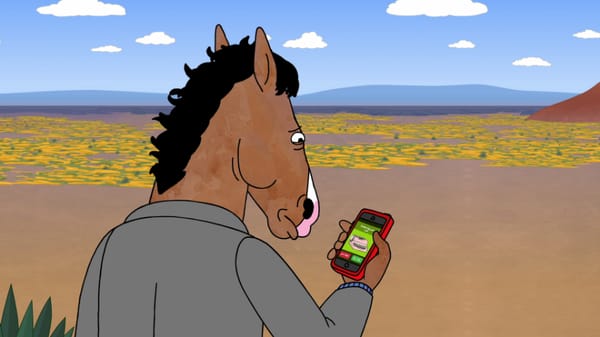Isle of Dogs: A cute tail that lacks some bite
Wes Anderson shows us how much he loves dogs and Japan in his latest film.

It’s been four years since the release of The Grand Budapest Hotel, a commercial and critical success for director Wes Anderson. It’s a tough act to follow, but Isle of Dogs is a delightful addition to Anderson’s body of work – his offbeat filmmaking style translates impressively to animation, which captures his playfully childish world with wonder.
It’s 20 years in the future, and in Japan’s Megasaki City’s authoritarian leader Mayor Kobayashi exiles all dogs to Trash Island due to an outbreak of canine flu virus. Six months later, Atari, the nephew of the Mayor, crash lands on Trash Island in search of his dog, Spots, who was the first dog banished by the decree. Atari is aided by a trusty band of five dogs, who are now given a purpose: to search for Spots, and ultimately rekindle the companionship between man and dogs.
Firstly, the film is a visual treat. The puppets and the sets are masterfully made, and there is pure joy in observing just how everything moves and interacts. The animation is beautiful and there is endless pleasure in the details that breathe life into this world and its characters. In the scenes on Trash Island, the visual style is greasy and gritty: it coherently captures an apocalyptic landscape, with mountains of debris, overgrown fields, smoggy skies, and rusty colour palettes. There is plenty for hardcore Anderson fans to fetishize, as the film is full of title cards, symmetrical shots, maps, deadpan dialogue, and almost everyone in the film is a complete introvert. Anderson obsesses over the framing, and his attention to detail in his composition is exactly what you would expect. It’s nothing new from Anderson; he does the thing he does best, and there is some comfort to that.
Like Anderson’s other films, Isle of Dogs has a darkly comic streak that has a sharp bite to it. Just ten minutes in, a brawl between dogs ends with an ear being chewed off and thrown away where rats nibble at it; Mayor Kobayashi’s moustached face is plastered onto a giant screen invoking images of Big Brother from 1984; there are scenes of dogs being rounded up into cages to be gassed; a young boy has bits of metal piping sticking out of the side of his head for an unhealthy amount of time. Moments of unexpected violence or dark themes become almost an antidote to the relentless kookiness. The abstract world that Anderson creates gets instantly grounded in reality and its consequences.
This undercurrent of violence is an important characteristic to Anderson’s storytelling style, as it reinforces the importance of the characters’ motives. In Isle of Dogs this is underplayed. As a result, the film sits awkwardly between the boundary of being an “animated kids’ film” or being a full-throttle Anderson film, and never quite decides which. With all the juggling of heavy ideas, Anderson fails to reach a satisfying conclusion. The narrative goes through several diversions that seem to swirl aimlessly around the point it wants to make.
While the film is clear in its stance against oppression and injustice, the primary voice of reason comes from Tracy, an American foreign exchange student with a hunch. This clouds the intentions of the film, and is at conflict with the socio-political subtext it tries to retain.
Many debates have been sparked on whether the film itself is racist: its touristy portrayal of Japan and the blissful ignorance of the majority of the Japanese people is somewhat problematic, but Anderson sets the film in Japan for largely aesthetic reasons, and shows that he is (at least superficially) in love with Japanese culture. There is a fantastical and celebratory air in the marriage between modern Western and ancient Asian traditions in Megasaki.
Does Isle of Dogs trivialise Japanese culture? I feel like Anderson would not have made a different film in light of these concerns, as his whole filmmaking style is based on an unbounded and childish creativity. The Japanese dialogue is not subtitled but translated through different characters or inferred through the voice acting and animation. This pushes for more sympathy towards the dogs who all speak English but don’t understand the Japanese. I didn’t find it offensive or racist, but I wonder how a Japanese speaking audience would view the film.
The film is successful in working on a number of different levels: a story about a boy finding his lost dog; a stance against corruption, xenophobia, and oppression; even as an advert for Japanese tourism. The film’s internal politics weren’t too concerning while I was watching it, but becomes more problematic as I think about it in retrospect. Isle of Dogs is the longest stop-motion animated film ever made, and it certainly feels it. The charm of the eccentric dialogue quickly wears off when it teters into overindulgence, especially in the final third. It isn’t as funny as it ought to be, and partly to blame is its ambiguity in whether it really wants to accommodate for younger audiences and portray a sugar-coated version of Anderson’s dark universe. Anderson may not be at his best, but Isle of Dogs brings joy as a visually arresting film that has flourishes of his signature tropes.
3.5 Stars
Dir: Wes Anderson. Script: Wes Anderson. Starring: Bryan Cranston, Edward Norton, Bill Murray, Jeff Goldblum. 101 minutes









